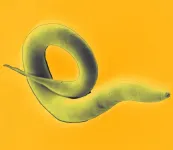(Press-News.org) Increased labour mobility seems to have stopped the racial wage discrimination of black English football players. A new study in economics from Stockholm university and Université Paris-Saclay used data from the English Premier League to investigate the impact of the so-called "Bosman ruling", and found that racial discrimination against English football players disappeared - but not for non-EU players. The study was recently published in the journal European Economic Review.
In 1995, the so-called Bosman ruling turned the labour market for European footballers upside down, introducing a free transfer market and greatly reducing the power of the football clubs. This ruling, named after the Belgian footballer Jean-Marc Bosman, lifted restrictions on the players' mobility based on the principle of free mobility of labour, as set out in the European Community Treaty. This decision was perceived as a fundamental shock to the system. Players in the EU were suddenly allowed to move to another club at the end of their contract without a transfer fee being paid, among other changes in the regulations for foreign football players in European leagues.
Could this abrupt change in conditions tell us something about racial discrimination on the labour market? Researchers in Economics Pierre Deschamps and José de Sousa thought so, and used the Bosman ruling to study how a change in the labour market power of firms could affect wage discrimination against black football players in the English Premier League.
"We find that wage discrimination against black English players was substantial before the Bosman ruling and then almost disappeared afterwards. Increasing labour mobility seemed to stop the clubs from being able to wage discriminate", said Pierre Deschamps, PhD in Economics at the Swedish Institute for Social Research (SOFI) at Stockholm University.
To be able to link the wage of a football player to his performance, the researchers used a method to identify discrimination, a so-called "market-test", on data from the English Premier League. This test detects wage discrimination by comparing teams with similar wage bills, but different shares of black players in the teams. By comparing the difference in performance between these clubs before and after the Bosman ruling, they could investigate how racial wage discrimination was affected.
Before the Bosman ruling, clubs had to pay transfer fees to recruit players who were out-of-contract. The situation was similar to the non-compete clauses often found in executive contracts, and increasingly in other types of jobs. As an example, Jean-Marc Bosman refused his club's (Liege) offer of a contract extension at only 25% of his old wage, and accepted a contract from the French club Dunkirk instead. Liege set a transfer fee that was high in order to prevent the transfer and force the player to sign the contract extension.
"This was a clear case of monopsony power - a situation where firms can limit labour market competition. After the ruling, players were free to leave for other clubs once their contracts had expired." said Pierre Deschamps.
Groups with less labor mobility still face wage discrimination
This change in labour market power for football players affected the possibility of discriminating black players, according to the researchers. After the ruling, the wages were more likely to reflect the talent of the black English players. But some groups still face mobility constraints however, non-EU players who have to obtain a work permit in front of a tribunal before they are allowed to play in England.
"When we look at the post-Bosman period, we find that the only players who face wage discrimination are black non-EU players. These players are the only ones who have to face both prejudice from clubs and restrictive contracting rules. This strengthens the case that contracting rules and labour mobility are key to limiting wage discrimination" says Pierre Deschamps.
The conclusion from the study is according to the researchers, that with the right labour market conditions, wage discrimination can be counteracted - even if employers are prejudiced.
"The important take-away from the article is that prejudice does not necessarily lead to wage discrimination. Acting against prejudice, although certainly desirable, is a longer-run endeavour with uncertain results. Limiting monopsony power and increasing labour market mobility can be done right away however, and in our dataset leads to an immediate decrease in wage discrimination." said Pierre Deschamps.
More about the study
The dataset was compiled by the authors, combining detailed team sheet data from the English Premier League from 1981 to 2008 with club wage bills from audited annual accounts. This dataset was then matched to data on the skin colour of football players, determined by visual inspection of players' photographs. Since the method is based on the players' appearance, it is suitable for determining the potential basis for discrimination, because discriminators prejudge an individual based on appearances.
The market-test method involves calculating the performance of a team from its wage bill and its share of black players. The main idea behind the test is that the racial composition of the team should have no effect on performance once we take the wage bills of clubs into account, unless there is racial discrimination. The researchers apply the market-test to data from the football matches, in this case the goal difference in a match. Having more black players in a team has a significant effect on performance in the 5 years before the Bosman ruling, but none afterwards, indicating that wage discrimination has disappeared
INFORMATION:
The study is peer reviewed and published in the June edition of the scientific journal European Economic Review.
Read more about the research:
Pierre Deschamps, José De Sousa, Labor mobility and racial discrimination, European Economic Review, Volume 135, 2021
Contact:
Pierre Deschamps
PhD in Economics
Swedish Institute for Social Research (SOFI)
Stockholm University
Tel: 08-16 36 39
Email: pierre.deschamps@sofi.su.se
Necessity is the father of invention, but where is its mother? According to a new study published in Science, fewer women hold biomedical patents, leading to a reduced number of patented technologies designed to address problems affecting women.
While there are well-known biases that limit the number of women in science and technology, the consequences extend beyond the gender gap in the labour market, say researchers from McGill University, Harvard Business School, and the Universidad de Navarra in Barcelona. Demographic inequities in who gets to invent lead to demographic inequities in who benefits from invention.
"Although the percentage of biomedical patents held by women has risen from 6.3% to 16.2% over the last three decades, ...
Researchers from Pompeu Fabra University (Barcelona, Spain) have analysed the way citizen science is practised in Spain. The paper, produced by Carolina Llorente and Gema Revuelta, from UPF's Science, Communication and Society Studies Centre (CCS-UPF) and Mar Carrió, from the University's Health Sciences Educational Research Group (GRECS), has been published in the Journal of Science Communication (JCOM).
Based on the study, a series of recommendations have been put forward to improve how citizen participation in science is carried out. Firstly, they suggest efforts be stepped up regarding the training given for assessing these initiatives or the creation of multi-disciplinary teams with a broad range of ...
Using an exceptionally preserved fossil from South Africa, a particle accelerator, and high-powered x-rays, an international team including a University of Minnesota researcher has discovered that not all dinosaurs breathed in the same way. The findings give scientists more insight into how a major group of dinosaurs, including well-known creatures like the triceratops and stegosaurus, evolved.
The study is published in eLife, a peer-reviewed open access scientific journal for the biomedical and life sciences.
Not all animals use the same techniques and organs to breathe. Humans expand and contract their ...
Researchers have shown how worms learn to optimise their foraging activity by switching their response to pheromones in the environment, according to a report published today in eLife.
The findings are an important advance in the field of animal behaviour, providing new insights on how sensory cues are integrated to facilitate foraging and navigation.
Foraging food is one of the most critical yet challenging activities for animals, with food often patchily distributed and other animals trying to find and consume the same resources.
An important consideration is how long to stay and exploit a food patch before moving on to find another. Leaving incurs the cost ...
Synthetic biology offers a way to engineer cells to perform novel functions, such as glowing with fluorescent light when they detect a certain chemical. Usually, this is done by altering cells so they express genes that can be triggered by a certain input.
However, there is often a long lag time between an event such as detecting a molecule and the resulting output, because of the time required for cells to transcribe and translate the necessary genes. MIT synthetic biologists have now developed an alternative approach to designing such circuits, which relies exclusively ...
AMHERST, Mass. - City sprawl and road development is increasingly fragmenting the habitats that many plant and animal species need to survive. Ecologists have long known than sustainable development requires attention to ecological connectivity - the ability to keep plant and wildlife populations intact and healthy, typically by preserving large tracts of land or creating habitat corridors for animals. New research from the University of Massachusetts Amherst argues that it's not enough for ecological modelling to focus on the landscape. If we want the best-possible ecological management, we should consider ...
DURHAM, N.C. -- Plant-based meat substitutes taste and chew remarkably similar to real beef, and the 13 items listed on their nutrition labels - vitamins, fats and protein -- make them seem essentially equivalent.
But a Duke University research team's deeper examination of the nutritional content of plant-based meat alternatives, using a sophisticated tool of the science known as 'metabolomics,' shows they're as different as plants and animals.
Meat-substitute manufacturers have gone to great lengths to make the plant-based product as meaty as possible, including adding leghemoglobin, an iron-carrying molecule from soy, and red beet, ...
Terence D. Capellini has been interested in how joints work for almost three decades. Part of it is due to personal experience, having sustained several joint injuries as a college ice hockey player and recently developing knee osteoarthritis. But the principal investigator of Harvard's Developmental and Evolutionary Genetics Lab has also seen the pain and limited mobility of loved ones who've received similar diagnoses and injuries.
"We have all these joints in the body and they don't look the same from one another," said Capellini, the Richard B. Wolf Associate Professor in the Department of Human Evolutionary ...
Pediatric melanoma is a rare disease with only around 400 cases diagnosed in the United States every year. To better understand this disease and how best to treat it, St. Jude Children's Research Hospital scientists created a registry called Molecular Analysis of Childhood MELanocytic Tumors (MACMEL). A paper on findings from the registry was published today in Cancer.
"What is different about the MACMEL registry is that it is prospective," said corresponding author Alberto Pappo, M.D., St. Jude Solid Tumor Division director. "We're seeing the vast majority of enrolled patients as part of the melanoma clinic at St. Jude. We can follow these patients and conduct detailed pathology and molecular analysis."
More ...
University of California San Diego School of Medicine researchers have identified a possible link between inadequate exposure to ultraviolet-B (UVB) light from the sun and an increased risk of colorectal cancer, especially as people age.
Reporting in the journal BMC Public Health, researchers investigated global associations between levels of UVB light -- one of several types of ultraviolet light that reach the Earth's surface -- in 2017 and rates of colorectal cancer across several age groups in 186 countries in 2018.
Lower UVB exposure was significantly correlated with higher rates of colorectal ...


